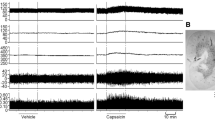Abstract
In the acute phase of myocardial infarction (MI) there are modifications of the autonomic outflow with an increase in the sympathetic tone and changes in cardiovascular reflexes. Activation of angiotensin ATI receptors in the nucleus tractus solitarii (NTS) inhibits the baroreceptor and enhances the carotid chemoreflex. In this study, we investigated the role of NTS-ATI receptors on the cardiovascular reflex responses evoked on stimulation of carotid chemoreflex and cardiac chemosensitive fibres in the acute phase of ML We also test the hypothesis that changes in cardiovascular responses to activation of carotid chemo and cardiac chemosensitive reflexes are secondary to changes in haemodynamic conditions due to infarction or to the activation of nociceptors of the heart. Rabbits were anaesthetised, paralysed and artificially ventilated. Carotid chemoreceptors and cardiac chemosensitive fibres were stimulated with lobeline and ATP, respectively. Arterial blood pressure, electrocardiogram and heart rate were monitored. A craneotomy was made to expose the Caudal portions of the medulla and a multibarreled glass microelectrode was inserted in order to allow the identification of NTS and the microinjection of losartan (an angiotensin ATI receptor antagonist). The heart was exposed by a midline thoracotomy and cardiac ischemia was produced by ligating the left descending coronary artery. The carotid chemoreflex and cardiac chemosensitive reflexes were evoked before and following the coronary ligation. The effect of losartan injection into the NTS on these reflexes was also assessed. In control experiments reflexes were assessed before and after the administration of capsaicin and procainamide. Results show that the activation of carotid chemoreflex elicited a greater increase of blood pressure and bradycardia after MI and than this was partially reversed by losartan microinjection after MI. Also the stimulation of cardiac chemosensitive fibres evoked a larger decrease on blood pressure and heart rate after MI and these were also partially reversed by losartan. The same enhancement of cardiovascular carotid chemo and cardiac chemosensitive receptors was observed after administration of capsaicin on the ventricular surface but not after procainamide. In conclusion, this study strongly suggests that, at NTS level, angiotensin ATI receptors are involved in the modifications of autonomic outflow observed in the acute phase of ML
Access this chapter
Tax calculation will be finalised at checkout
Purchases are for personal use only
Preview
Unable to display preview. Download preview PDF.
Similar content being viewed by others
References
Baron, HV, Lesh, MD (1996). Autonomic nervous system and sudden death. J Am. Coll. Cardiol., 27: 1053–60
Heymans C, Neil, E (1958). The effect of drugs on the chemoreceptors. In: Reflexogenic Areas of the Cardiovascular System. Churchill, London, pp 192
Jordan, D (1990). Autonomic changes in afective behavior. In: “Central Regulation of Autonomic Function”. Ed.: A.D.Loewy and K.M.Spyer, Oxford University Press
Kasparov, S, Paton, JFR (1999). Differential effects of angiotensin II in the nucleus tractus solitarius-II- Plausible neuronal mechanisms. J.Physiol., 521: 227–238
Lind, RW, Swanson, LW, Ganten, D (1985). Organization of angiotensin II immunoreactive cells and fibres in the rat central nervous system. An immunohistochemical study. Neuroendocrinol., 40: 2–24
McQueen, MS, Bond, SM, Moores, C, Chesssell, I, Humphrey, PP, Dowd, E. (1998) Activation of P2X receptors for adenosine triphosphate evokes cardiorespiratory reflexes in the anaesthetised rats. J. Physiol, 507 (3):843–55
Meessen, H, Olszewski, J (1949) Cytoarchitektonischer Atlas des Rautenhirns des Kaninchens, S. Krager
Paton, JFR, Kasparov, S (1999). Differential effects of angiotensin II on cardiovascular reflexes mediated by nucleus tractus solitarius-a microinjection study. J.Physiol., 521: 213–225
Paton, JFR, Kasparov, S (2000). Sensory channel specific modulation in the nucleus of the solitary tract. J.Aut.Nerv.Syst., 80: 117–129
Rocha, I, Rosârio, LB, Oliveira, EI, Barros, MA, Silva-Carvalho, L Changes in arterial and cardiac chemosensitive reflexes after acute heart ischemia in the anaesthetized rabbit. Submitted
Schwartz PJ, Zaza A, Pala M, Locati E, Beria G, Zanchetti A (1988) Baroreflex sensitivity and its evolution during the first year after myocardial infarction. J; Am. Coll; Cardiol 12(3): 629–636
Silva-Carvalho, L, Dawid-Milner, MS, Spyer, KM (1995). The pattern of excitatory inputs to the nucleus tractus solitarii evoked on stimulation in the hypothalamic defence area in the cat. J.Physiol., 487.3: 727–737
Sugiyama, A, Takehana, S, Kimura, R, Hashimoto, K (1999) Negative chronotropic and inoytropic effects of class I antiarrhythmic drugs assessed in isolated canine blood-perfused sinoatrial node and pappilary muscle preparations. Heart Vessels, 14(2): 96–103
Zhang W, Huang BS, Leenen FH (1999) Brain renin-angiotensin system and sympathetic hyperactivity in rats after myocardial infarction. A. J. Physiol. 276(5/2): H1608–H1615
Author information
Authors and Affiliations
Editor information
Editors and Affiliations
Rights and permissions
Copyright information
© 2003 Springer Science+Business Media New York
About this paper
Cite this paper
Rosârio, L.B., Rocha, I., Silva-Carvalho, L. (2003). Effect of Losartan Microinjections into the NTS on the Cardiovascular Components of Chemically Evoked Reflexes in a Rabbit Model of Acute Heart Ischemia. In: Pequignot, JM., Gonzalez, C., Nurse, C.A., Prabhakar, N.R., Dalmaz, Y. (eds) Chemoreception. Advances in Experimental Medicine and Biology, vol 536. Springer, Boston, MA. https://doi.org/10.1007/978-1-4419-9280-2_54
Download citation
DOI: https://doi.org/10.1007/978-1-4419-9280-2_54
Publisher Name: Springer, Boston, MA
Print ISBN: 978-1-4613-4873-3
Online ISBN: 978-1-4419-9280-2
eBook Packages: Springer Book Archive




